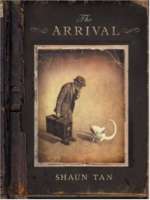by Carmen M. Martínez-Roldán, University of Texas, Austin, TX
 The IBBY Congress offered multiple opportunities for learning about the reading experiences offered to children in different parts of the world. One of those experiences that was the focus of lively discussions involved children reading wordless texts in the project, “Visual journeys: Understanding immigrant children’s responses to the visual image in contemporary picture books.” Dr. Evelyn Arizpe, from the University of Glasgow, coordinator of the project, Dr Cecilia Silva-Díaz and Brenda Bellorín, from the Universitat Autonoma de Barcelona, and myself from The University of Texas at Austin, shared the power of the visual image in the graphic novel The Arrival by Shaun Tan (2006) with linguistically different audiences in two workshops. We engaged the participants in reading and responding to the images of The Arrival and shared what we have learned about children’s responses to the text.
The IBBY Congress offered multiple opportunities for learning about the reading experiences offered to children in different parts of the world. One of those experiences that was the focus of lively discussions involved children reading wordless texts in the project, “Visual journeys: Understanding immigrant children’s responses to the visual image in contemporary picture books.” Dr. Evelyn Arizpe, from the University of Glasgow, coordinator of the project, Dr Cecilia Silva-Díaz and Brenda Bellorín, from the Universitat Autonoma de Barcelona, and myself from The University of Texas at Austin, shared the power of the visual image in the graphic novel The Arrival by Shaun Tan (2006) with linguistically different audiences in two workshops. We engaged the participants in reading and responding to the images of The Arrival and shared what we have learned about children’s responses to the text.
One highlight was participation in an Annotated Task, a strategy we used with children in the project. Each person received a large copy of an image of The Arrival, and was invited to write annotations around the margins or inside the image. We allowed time for participants to think, see, wonder, and write, using questions such as: “What does it remind you of? How do you read this visual? What emotions does it evoke?” Individually each wrote the ideas the image conveyed to them and then exchanged their annotations with a partner and discussed their responses. We had a wonderful discussion with the whole group. Finally, we shared annotations by a small group of students from Barcelona in response to the same image.
It was clear that the participants, the same as the children, drew from their experiences with immigration, popular culture and media, and texts in their interpretive work. The social nature of the reading process was evident as participants negotiated meanings and interpretations among themselves. These workshops, as well as our experiences with immigrant children in the international project, left us with ideas to wonder and consider as we keep working to engage all readers with good literature, especially wordless complex texts:
-
- •Picture books have great potential for engaging readers and developing visual and critical literacy skills.
-
- •Wordless texts require careful looking in order to decode visual signs, construct sequences, speculate and generate hypothesis.
-
- •Strategies that encourage careful looking and thinking about these texts are important to bring in shared experiences and knowledge for deeper understanding.
-
- •Responding to the visual image in picture books and graphic novels helps create a sense of community among readers with diverse cultural backgrounds.
- • Although individual responses to texts are important, we need to consider the social nature of reading and provide opportunities for reader to share and negotiate meanings and interpretations.
Note: A copy of the IBBY paper by Dr. Evelyn Arizpe is available in both pdf or MSWord format.
Journey through Worlds of Words during our open reading hours: Monday-Friday, 9 a.m. to 5 p.m. and Saturday, 9 a.m. to 1 p.m.
- Themes: Arrival, Carmen M. Martínez-Roldán, shaun tan
- Descriptors: Books & Resources, Debates & Trends, Student Connections, WOW Currents

I have been reading a lot of wordless picture books recently for class. I have thought of using them for creative writing exercises and other related topics. However, I did not think of using them with students who have immigrated or with English language learners. This would be a great way to engage them in literature and build their confidence and skills and gradually move struggling readers to more complex texts. It is good to know that there are multiple ways in which to use these texts, because many of the wordless books I am reading now are great and want to be able to utilize them as much as possible.
I have never seen a wordless book. I think it is a great idea. It helps the reader to dig deep into the text.
We have a large task as a society at hand, and that is we must engage in reaching our immagrant population. Rather or not we as a whole agree with there existance here, there is an important ergency to help them understand our culture and way of life. We must not expect them to look at things and litereature as we do. We must understand that they have a completely different mind make-up that sees, thinks, and understands completely different. This is such wonderful news to see that there are workshops that are available to immigrants and that we are trying to better accommodate these students.
I have read a lot of picture books, but none of them completely wordless. You could really let your imagination take over with this book.